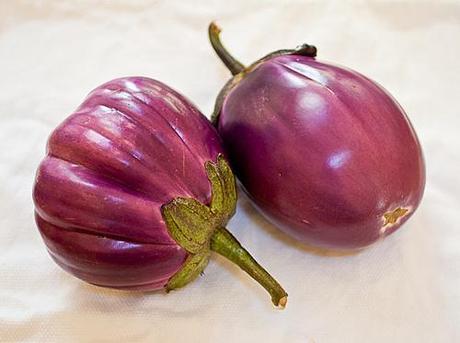
The thing is, despite that intro, I’m a big fan of eggplant, but I admit it’s tricky to deal with. When I was in Spain, my host family always salted their eggplants before breading and frying them, so that’s my method of choice (I’ve seen cutting out the seeds mentioned as well). I admit, though, to sometimes engaging in a bit of Russian roulette and charging on forward without precautionary measures. I’m here to tell the tale. And yet…salting is a worthwhile step as it handles the other bugbear, the texture. The juices are drawn out of your big purple vegetable-fruit, and the slices go from being almost artificially springy to soft and meltingly tender when cooked.
And I’ll just let the pictures speak for themselves (well not exactly–I can’t help providing a few tips for salting eggplant I’ve learned along the way).
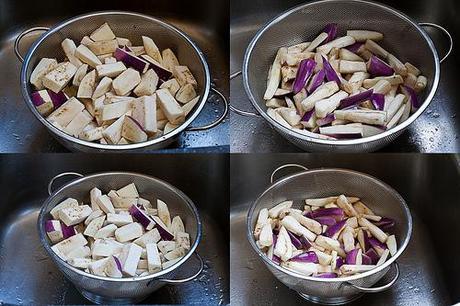
It’s amazing to see how much volume is lost in the process, as the pictures above show–firm batons of eggplant start to collapse and soften. And that’s just the beginning–the next step is to bundle the eggplant in a kitchen towel and squeeze with abandon (or aggression). You’ll be shocked at how much moisture you manage to wring out. Throw that stress ball out, and just eat more eggplant!

The picture above is about half of the eggplant, compacted down after much twisting and pressing. Please don’t use a paper towel (you’ll drive yourself nuts and waste time picking of little bits of shredded paper that have adhered to your otherwise lovely vegetable), and please do it over the sink! It’s a few minutes (but only a few) of intense work, but think of it as a down payment on the pancetta, olive oil, and vegetable oil that you’re about to be playing liberally with. (I’ll get to that). And there’s no harm in taking a little break.
OK, so you know that this recipe I’m going to be talking about just might be featuring eggplant. And even though eggplant is certainly a vegetable that holds it own as a meat substitute, there’s no reason it can’t share the stage–so I decided to try Marcella Hazan’s recipe for chicken fricasseed with eggplant and fresh tomatoes. Soon I was digging up some chicken parts from my freezer to get a head start on the next day’s meal, and checking my stocks of olive oil and pancetta. Marcella’s not diet food.
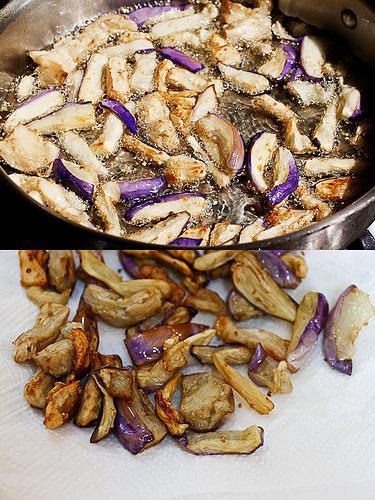
You could think of this recipe as almost two in one: the eggplant is fried on its own, while the chicken is sautéed with tomatoes and pancetta. Only at the last minute do you unite the two, where their flavors instantly meld together. And since the recipe proceeds on these parallel tracks, you can start one step ahead of the other to get a head start–and in fact I fried up my eggplant in the afternoon, and finished the remainder of the meal quickly before dinner.
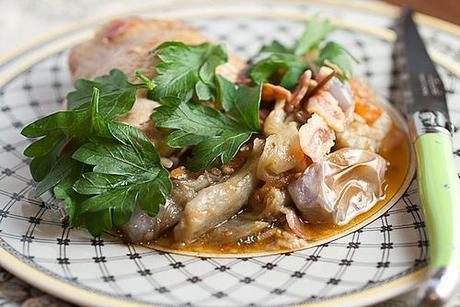
Chicken and eggplant seem an unusual pairing, but the eggplant almost melts into a sauce with the tomatoes, and the pancetta brings all the elements together. (My husband, who is less enthusiastic about eggplant than I, noted that it’s the pancetta that makes the dish, though he’d probably say that about any meal with pancetta). While decidedly making the best of late summer produce, it’s a meal that still sticks to your ribs and is deeply satisfying. And a fitting adieu to summer.
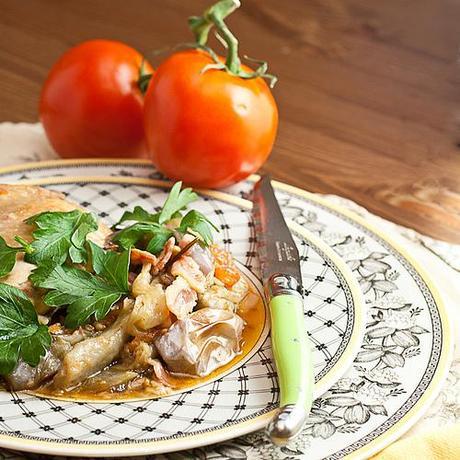
Adapted from Marcella’s Italian Kitchen
Fricasseed Chicken with Eggplant and Fresh Tomatoes Print
Ingredients- 1 1/2 to 2lb eggplant
- salt
- vegetable oil for frying
- 2 medium fresh tomatoes
- 2 1/2 to 3lb chicken parts (a whole chicken cut into 10 pieces or chicken pieces to equal this weight)
- 2T olive oil
- 2 garlic cloves
- 1/2c dry white wine
- 1/4 lb pancetta
- parsley
- Cut the eggplants into small batons, about 1-inch wide by 3 inches long. Layer into a colander with liberal sprinklings of salt, then toss to further combine. Allow to stand over your sink for about an hour. This draws out the juice and with it, any bitterness in the eggplant.
- Peel your tomatoes with a serrated peeler and chop. Chop up the pancetta and garlic as much as you can as well.
- Close to the hour mark, pour the olive oil into a deep saute pan and when hot, add the pancetta and garlic. When the garlic just starts to turn pale gold, add the chicken, skin side down. (Ideally, to get beautifully browned chicken you will need to pat the skin dry with paper towels. As you can see, I forgot to do this and it was still delicious, so don’t stress if you forget or don’t get it quite dry enough). Brown the chicken on one side, then the other. Add the wine, and once the alcohol has boiled away, add the tomatoes and parsley. Turn the chicken from time to time while it cooks.
- Meanwhile, squeeze the eggplant to draw out any further moisture. As pictured, this is best done with a cloth kitchen towel, and is best done by forcefully kneading and then wringing out the liquid. You will be surprised at how much additional liquid is released, particularly with a fresh eggplant. Heat the vegetable oil in a deep skillet–the original recipe called for pouring in enough oil so as to be 1/2-inch deep, but I got by with far less, perhaps a quarter inch. When it is hot (test it by slipping in a small eggplant piece; it should immediately sizzle) add about a third to a half of your eggplant batons. You do not want to crowd the eggplant as it will not brown as nicely. You also risk lowering the temperature of the oil which will render soggy, oily eggplant. Turn occasionally. When cooked to a golden brown (about 6-7 minutes) remove to a paper towel to drain and continue with the remaining eggplant. (You can prepare the eggplant in advance and refrigerate).
- When the chicken is done or nearly done, add the fried eggplant and cook about 5 minutes more. Some of the eggplant may disintegrate into the sauce–this is fine. Serve immediately with more fresh parsley. (Note that the original recipe recommends pouring off some of the fat before adding the eggplant. I didn’t do this though calorie-wise, it would probably have been a good idea).

